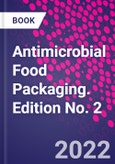Antimicrobial Food Packaging, Second Edition continues to be an essential resource covering all aspects in the development and application of novel antimicrobial films to all types of packaged foods. The book is organized in six parts to include the main backgrounds and frameworks of the topic, types of packaging materials and packaging systems and the migration of packaging elements into food, the most relevant established and emerging technologies for microbial detection in food systems, the development and application of antimicrobial packaging strategies to specific food sectors, and the most promising combinational approaches, also including combinational edible antimicrobial coatings.
Useful to a wide audience of researchers, scientists, and students, the new edition brings five new chapters that include the latest information on smart packaging for monitoring food quality, postbiotics in antimicrobial packaging applications, emerging hydrocolloids from food processing waste or novel antimicrobial packaging strategies in dairy products.
Please Note: This is an On Demand product, delivery may take up to 11 working days after payment has been received.
Table of Contents
1. The Nature and Extent of Foodborne Disease2. Resistant and Emergent Pathogens in Food Products
3. Bacterial Contamination in Food Production
4. Fungal Contamination in Packaged Foods
5. Viral Contamination of Food
6. The Downside of Antimicrobial Packaging: Migration of Packaging Elements into Food
7. Packaging Material in the Food Industry
8. Effect of Packaging Systems on the Inactivation of Microbiological Agents
9. Antimicrobial Susceptibility Testing of Foodborne Bacteria Related to National and International Resistance-Monitoring Programs
10. Food Safety: Good Manufacturing Practices (GMP), Sanitation Standard Operating Procedures (SSOP), Hazard Analysis and Critical Control Point (HACCP)
11. Control of Microbial Activity Using Antimicrobial Packaging
12. Detection of Foodborne Pathogens Using Biosensors
13. Detection of Foodborne Pathogens Using DNA Arrays
14. Detection of Foodborne Pathogens Using Nanoparticles. Advantages and Trends
15. Detection of Foodborne Pathogens Using MALDI-TOF Mass Spectrometry
16. Industrial Applications: Regulatory Issues and Life Cycle Assessment of Food Packaging
17. Antimicrobial Packaging for Meat Products
18. Antimicrobial Packaging for Fresh and Minimally Processed Fruits and Vegetables
19. Antimicrobial Packaging for Poultry
20. Antimicrobial Packaging for Seafood
21. Antimicrobial Packaging of Beverages
22. Antimicrobial Active Packaging Systems Based on EVOH Copolymers
23. Ethyl Lauroyl Arginate (LAE): Antimicrobial Activity and Applications in Food Systems
24. Ethyl Lauroyl Arginate (LAE): Usage and Potential in Antimicrobial Packaging
25. Volatile Compounds Usage in Active Packaging Systems
26. Carvacrol-Based Films: Usage and Potential in Antimicrobial Packaging
27. Gelatin-Based Nanocomposite Films: Potential Use in Antimicrobial Active Packaging
28. Smart Nanohydrogels for Controlled Release of Food Preservatives
29. Antimicrobial Food Packaging Based on Biodegradable Materials
30. Pullulan: A Suitable Biopolymer for Antimicrobial Food Packaging Applications
31. Use of Metal Nanoparticles for Active Packaging Applications
32. Silver-Based Antibacterial and Virucide Biopolymers: Usage and Potential in Antimicrobial Packaging
33. Antimicrobial Food Packaging Incorporated with Triclosan: Potential Uses and Restrictions
34. Zinc Oxide Nanoparticles for Food Packaging Applications
35. Antimicrobial Spices: Use in Antimicrobial Packaging
36. Pediocin Applications in Antimicrobial Food Packaging Systems
37. Casein and Chitosan Polymers: Use in Antimicrobial Packaging
38. Multifunctional Films, Blends, and Nanocomposites Based on Chitosan: Use in Antimicrobial Packaging
39. Cinnamaldehyde and Eugenol: Use in Antimicrobial Packaging
40. Enzybiotics: Application in Food Packaging
41. Zein and Its Composites and Blends with Natural Active Compounds: Development of Antimicrobial Films for Food Packaging
42. Casein-Based Zataria multiflora Boiss Films: Use in Antimicrobial Packaging
43. Antimicrobial Peptides from Bacillus spp.: Use in Antimicrobial Packaging
44. Chitosan-Oregano Essential Oil Blends Use as Antimicrobial Packaging Material
45. Thymol: Use in Antimicrobial Packaging
46. Organic Acids: Usage and Potential in Antimicrobial Packaging
47. Combinational Approaches for Antimicrobial Packaging: Chitosan and Oregano Oil
48. Combinational Approaches for Antimicrobial Packaging: Lysozyme and Lactoferrin
49. Combinational Approaches for Antimicrobial Packaging: Natamycin and Nisin
50. Combinational Approaches for Antimicrobial Packaging: Pectin and Cinnamon Leaf Oil
51. Combinational Approaches for Antimicrobial Packaging: Bivalve Shell Waste-Derived Material and Silver
52. Combinational Edible Antimicrobial Films and Coatings








